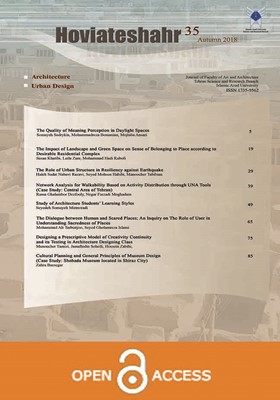Designing a Prescriptive Model of Creativity Continuity and its Testing in Architecture Designing Class
Subject Areas : architecture
Manouchehr Tamizi
1
,
Jamaleddin Soheili
2
![]() ,
Hossein zabihi
3
,
Hossein zabihi
3
1 - Department of architecture, Qazvin Branch, Islamic Azad University, Qazvin, Iran
2 - Assistant Professor of Qazvin Branch, Islamic Azad University, Qazvin, Iran.
3 - دانشیار و عضو هیت علمى گروه معمارى، دانشگاه آزاد اسلامى قزوین، واحد علوم و تحقیقات، قزوین، ایران.
Keywords: Architectural design, Creative education, Continuity of creativity, Designing model,
Abstract :
The issues of architectural design training, should always be considered as the priority of the architecture system planners, so that the educational centers would benefit from its results. The teaching of architectural designing in designing workshops (especially in Iran) as a pivot of architecture education was in agreement by all scholars of educational and architectural problems. Training and the process of training in architectural design is one of the most important ways of demonstrating and developing creativity in the educational environment. But there is currently no specific pattern that faculty can effectively use in the course of designing architectural lessons. However, the mere reliance on the traditions of architectural education or compliance is not merely a common criterion for academic instruction appropriate to the development of architectural education. This research examines the designing and testing of a prescriptive model (Continuity of creativity model) for the continuity of creativity in architectural design classes. A prescriptive model based on analytical-structural implications of existing objective models and with continuity attitude was arrived to, then, to test the model, a semi-experimental method was used to test the hypothesis. The statistical society of the study is consisted of all students of plan No.4 of Mahshar Azad University studying in BA of architecture in 2016-17 in Azad University of Mahshahr. Due to the small size of the population, 30 of them were randomly assigned into two groups of control (15) and experimental (15). Data analysis was conducted using SPSS.15 software. The prescriptive model indices were verified by professors and architects in using Laserl software. The results showed that education is a creative process composed of an educational procedure including phases such as producing of solution idea, recommending and introducing an idea, idea evaluation, reviewing, final adoption, and making decision. As the prescriptive model focuses on the role of educational process method by professor and students` participation in learning process, the effectiveness of developing students` unconscious mind by following brain storm, the evaluation of ideas prior to hasty decision, and considering reviewing in idealization of this model was approved. It results in positive attitude, improving satisfaction, and increasing creativity in learners. The students who were trained according to the prescriptive model had higher satisfaction, more positive attitude toward the course, had a better attitude toward increasing their creativity during the design process than the course based on common approaches. “Continuity of creativity” model can play a more effective role in the in achieving the goal of promoting/ enhancing creativity of students than traditional teaching methods. Students could start, organize, and proceed design process by getting help from professors to achieve a favorable result. This theory can be a guide for practice in organizing architectural design classes to enhance learners' creativity. It is worth noting that this model is not defective and does not claim to address all educational inadequacies in the design of architecture, since this claim requires years of research and the testing of the model and conducting meta-analytical and systematic studies on the findings of numerous studies.
1. آقایی فیشانی، تیمور. (1377). خلاقیت و نوآوری در انسانها و سازمانها. چاپ اول. تهران: انتشارات ترمه،.
2. حجت، عیسی. (1383). آموزش خلاق-تجربه 81. نشریه هنرهای زیبا، 18، 25-36.
3. حقشناس، مرجان (1378). خلاّقیت در آموزشوپرورش. فصلنامه مدیریت در آموزشوپرورش، 24-23.
4. مهدوی نژاد، محمد جواد. (1384). آفرینش گری و روند آموزش خلاقانه در طراحی معماری. مجله علمی پژوهشی هنرهای زیبا، 21، 66-57.
5. محمودی، امیر سعید. (1383). تفکر در طراحی: معرفی الگوی تفکر تعاملی در آموزش طراحی. نشریه هنرهای زیبا، 20، 27-36.
6. محمودی، امیر سعید. (1381). چالشهای آموزش طراحی معماری در ایران: بررسی دیدگاه اساتید و دانشجویان. مجله هنرهای زیبا، 12، 70-79.
7. محمودی، امیرسعید. (1377). آموزش روند طراحی معماری (بهکارگیری استعدادهای نهفته دانشجویان). مجله هنرهای زیبا، 4 و 5، 73-81.
8. منینجر، ویلیام؛ مایر، جان؛ وایتسمن، الیس. (1370). رشد شخصیّت و بهداشت روان. چاپ سوم. تهران: انجمن اولیاء و مربّیان جمهوری اسلامی ایران.
9. ندیمی، حمید. (1378). جستاری در فرآیند طراحی. نشریه علمی و پژوهشی صفه، 29، 95-103.
10. نلر، جورج اف. (1369). هنر و علم خلاقیت. (سید علی اصغر مسدد، مترجم). چاپ اول. شیراز: انتشارات دانشگاه شیراز.
11. Baas, M., Dreu, C., & Nijstad, B. (2008). A meta-analysis of 25 years of mood-creativity. Psychoogicall Bultinl, 6)134(, 779-806.
12. Cross, N., & Cross, A.C. (1995). An Observation of teamwork and Social Processes in Design. Journal of Design Studies, 16(2), 143-170.
13. Jonassen, D. H. & Hernandez-Serrano, J. (2002). Case-based reasoning and instructional design: Using stories to support problem solving. Educational Technology Research and Development, 50 (2), 65-77.
14. Lawson B. (2005). How Designers Think: The Design Process Demystified. (4th ed.). London and New York: Routledge Publisher.
15. Ledewitz, S. (1985). Models of design in studio teaching. Journal of Architectural Education, 38 (2), 2-8.
16. Lyie, J.T. (1999).Design for Human Ecosystems. Washington, DC: Island Press.
17. Lynch K. & Hack G. (1984). Site planning. Cambridge Mass. London, England: MIT Press.
18. Schön, D.A., & Wiggins, G. (1988). Kinds of Seeing and their Functions in Designing. Design Studies, 13 (2), 135-156


